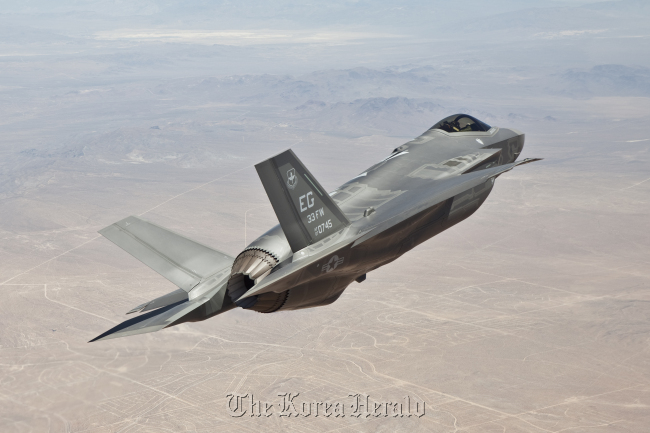Controversy is growing over Lockheed Martin being unable to allow Korean pilots to test-fly its F-35 fighter jet ahead of Seoul’s decision in October on who will win its massive procurement project.
The U.S. defense firm confirmed on Sunday that Korea will not be able to fly the aircraft as the development of the single-seat stealth fighter jet has yet to be completed.
“At this time the F-35 fleet is fully occupied with test, training and delivery activities, so Korea will not be able to fly the aircraft,” Lockheed Martin said in an email.
“Potential customers like Korea have the opportunity for multiple pilots to fly the high-fidelity Manned Tactical Simulator similar to operations conducted by the U.S. Services and F-35 international partners and customers.”
The F-35 is one of the strongest candidates in the so-called FX-III project. Under the project, the Seoul government plans to purchase a high-end fleet of about 60 fighter jets with a budget of around 8.3 trillion won ($7.06 billion), seeking to deploy them from 2016.
 |
F-35 |
Other candidates are Boeing’s F-15 Silent Eagle and the Eurofighter Typhoon made by European Aeronautic Defense and Space Company N.V.
As it is Seoul’s mammoth project to bolster its air power, which is critical in modern warfare, critics said that test-flying the expensive product is crucial, and that the simulation test is insufficient.
“Even if we were not able to test-fly any high-level aerial maneuvers, we, at least, need to feel and check it firsthand. Testing it only with a simulator is not sufficient,” said Yang Uk, a senior research fellow at Korea Defense and Security Forum.
“As it is a single-seat platform, it is difficult for an untrained pilot to fly it alone. It would take much time to train a pilot for the test flight itself. For this, we don’t have enough time before October when we choose the winner of the FX-III project.”
Amid this controversy, Lockheed Martin highlighted the credibility of its simulator.
“The F-35 has a classified, high-fidelity Manned Tactical Simulator that is used by the three U.S. services, eight partner nations and other potential operators to evaluate the F-35 and develop 5th Generation tactics,” the company said.
“All of the international nations who have selected and ordered the F-35 have evaluated its capabilities using the Manned Tactical Simulator.”
For the project, Seoul is to conduct an onsite evaluation of the F-35 in July, the F-15SE in August and the Eurofighter Typhoon in September.
The only completed fighter is the Eurofighter Typhoon. Boeing’s F-15SE is expected to use its existing F-15 platform for the test flight, sources said. Critics say that it would be unfair to test only the F-35 using the simulator.
The Defense Acquisition Program Administration in charge of the project said that the procedures for the flight test have yet to be finalized as they are to submit their proposals on the procurement project on June 18.
“We will use all available methods to test candidate fighters should we be unable to test-fly (the F-35). It is inappropriate to say that it is just nothing just because we cannot test-fly it,” a DAPA official told The Korea Herald, declining to be named.
“We will purchase the aircraft that will be used for the next three decades. It is like purchasing items in the spot market or futures market.”
DAPA Commissioner Noh Dae-lae said that the controversy stems from the decision to include the “fighter of the future” into the competition, apparently hinting that it is not a serious problem to test the F-35 using a simulator.
“The question is whether to include the F-35 on the candidate list and make the project more competitive. It is a matter of which one is to serve the national interests better,” he said on his Twitter account.
Lockheed Martin calls it the “only all-aspect stealthy fifth-generation” fighter.
But rising costs and delays in its development have apparently sapped confidence in the massive program to make the new radar-evading fighter that involves nine countries including the U.S.
Boeing has focused on its fighter jet’s cost-effectiveness and “tactically useful” radar cross section reduction. But critics doubt the stealth capabilities of the F-15SE, calling it a “semi-stealth jet” compared with the F-35.
The Seoul government has recently begun moving faster to secure stealth fighters as calls have persisted for the military to acquire strategic precision-guided weaponry that can deal with asymmetrical threats from the North.
By Song Sang-ho (
sshluck@heraldcorp.com)







![[Today’s K-pop] Blackpink’s Jennie, Lisa invited to Coachella as solo acts](http://res.heraldm.com/phpwas/restmb_idxmake.php?idx=644&simg=/content/image/2024/11/21/20241121050099_0.jpg)
